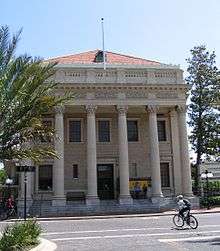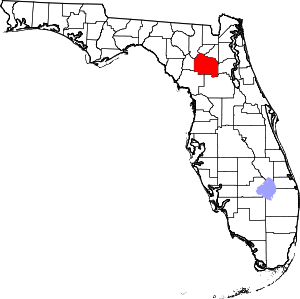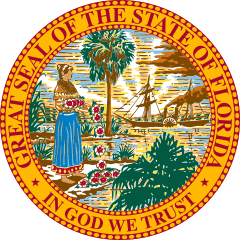Gainesville, Florida
Gainesville is the county seat of, and the largest city in, Alachua County, Florida, and is both the principal city of the Gainesville, Florida, metropolitan statistical area and the largest city in North Central Florida. In 2019 the US Census Bureau estimated Gainesville's population at 133,997,[7] a 7.6% increase from 2010, and the metropolitan statistical area's population at 288,212.[9]
Gainesville, Florida | |
|---|---|
City | |
| City of Gainesville | |
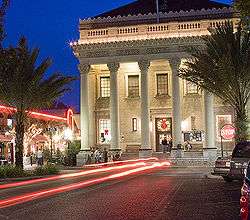 Downtown Gainesville at night | |
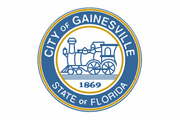 Flag  Seal | |
| Nickname(s): | |
| Motto(s): Citizen centered. People empowered. | |
 Location in Alachua County and the state of Florida | |
| Coordinates: 29°39′7.19″N 82°19′29.97″W | |
| Country | |
| State | |
| County | Alachua |
| Settled | 1854 |
| Incorporated | April 14, 1869 |
| Government | |
| • Type | Council-manager |
| • Mayor | Lauren Poe (D) |
| • City Commission | List
|
| • City Manager | Lee R. Feldman, ICMA-CM[3] |
| Area | |
| • City | 64.24 sq mi (166.39 km2) |
| • Land | 63.07 sq mi (163.34 km2) |
| • Water | 1.18 sq mi (3.04 km2) 1.74% |
| Elevation | 152 ft (54 m) |
| Population | |
| • City | 124,354 |
| • Estimate (2019)[7] | 133,997 |
| • Rank | 204th |
| • Density | 2,124.64/sq mi (820.33/km2) |
| • Urban | 187,781 (US: 187th) |
| • Metro | 288,212 (168th) |
| • CSA | 400,814 (US: 99th) |
| Time zone | UTC−5 (EST) |
| • Summer (DST) | UTC−4 (EDT) |
| ZIP code | 32601–32614, 32627, 32635, 32641, 32653 |
| Area code | 352 |
| FIPS code | 12-25175 |
| GNIS feature ID | 0282874[8] |
| Website | www |
Gainesville is home to the University of Florida, the fifth-largest public university campus by enrollment in the United States.
History
There is archeological evidence, from about 12,000 years ago, of the presence of Paleo Indians in the Gainesville area, although it is not known if there were any permanent settlements.[10] A Deptford culture campsite existed in Gainesville and was estimated to have been used between 500 BCE and 100 CE.[11] The Deptford people moved south into Paynes Prairie and Orange Lake during the first century and evolved into the Cades Pond culture.[12] The Deptford people who remained in the Gainesville area were displaced by migrants from southern Georgia sometime in the seventh century.[12] These migrants evolved into the Alachua culture and they built their burial mound on top of the Deptford culture campsite.[11] When Europeans made first contact in the area, the Potano lived in the area. They were descendants of the Alachua culture people.[13] European contact diminished the numbers of native peoples (through disease, enslavement, war) and Spanish colonists began cattle ranching in the Paynes Prairie area in the 18th century. The Spanish ceded Florida to the US in 1821.[14]
Gainesville was established in 1854 and named after Edmund P. Gaines.[15][16] The town of Gainesville was incorporated in 1869[17] and chartered as a city in 1907.[18] The University of the State of Florida was moved from Lake City to Gainesville in 1906 and its name was simplified to University of Florida in 1909.[18][19]
Geography
Gainesville is located at 29°39'55" North, 82°20'10" West (29.665245, −82.336097),[20] which is roughly the same latitude as Houston, Texas. According to the United States Census Bureau, the city has a total area of 62.4 square miles (161.6 km2), of which 61.3 square miles (158.8 km2) is land and 1.1 square miles (2.8 km2) is water. The total area is 1.74% water.[21]
Gainesville's tree canopy is both dense and species rich, including broadleaf evergreens, conifers, and deciduous species; the city has been recognized by the National Arbor Day Foundation every year since 1982 as a "Tree City, USA". A 2016 ecological assessment indicates Gainesville's urban tree canopy covers 47 percent of its land area.[22]
Gainesville is the only city with more than 10,000 residents in the Gainesville, Florida, metropolitan statistical area (Alachua and Gilchrist counties), and it is surrounded by rural area, including the 21,000-acre (8,500 ha) wilderness of Paynes Prairie on its southern edge. The city is characterized by its medium size and central location, about 90 minutes' driving time from either Jacksonville or Orlando, two hours from Tampa, and five hours from either Atlanta or Miami. The area is dominated by the University of Florida,[23] which in 2008 was the third-largest university by enrollment in the US,[24] and as of 2016 was the fifth-largest.
Climate
| Gainesville | ||||||||||||||||||||||||||||||||||||||||||||||||||||||||||||
|---|---|---|---|---|---|---|---|---|---|---|---|---|---|---|---|---|---|---|---|---|---|---|---|---|---|---|---|---|---|---|---|---|---|---|---|---|---|---|---|---|---|---|---|---|---|---|---|---|---|---|---|---|---|---|---|---|---|---|---|---|
| Climate chart (explanation) | ||||||||||||||||||||||||||||||||||||||||||||||||||||||||||||
| ||||||||||||||||||||||||||||||||||||||||||||||||||||||||||||
| ||||||||||||||||||||||||||||||||||||||||||||||||||||||||||||
Gainesville's climate is defined as humid subtropical (Köppen: Cfa). Due to its inland location, Gainesville experiences wide temperature fluctuations, and it is part of USDA Plant hardiness zone 9a.[25] During the hot season, from roughly May 15 to September 30, the city's climate is similar to the rest of the state, with frequent afternoon thunderstorms and high humidity. Average temperatures range from the low 70s (21–23 °C) at night to around 92 °F (33 °C) during the day.[26] The all-time record high of 104 °F (40 °C) was reached on June 27, 1952.[27] From November through March, Gainesville experiences a somewhat different climate from much of Florida, with 16 nights[27] of temperatures at freezing or below and sustained freezes every few years. The all-time record low of 6 °F (−14 °C) was reached on February 13, 1899,[28] and the city experienced light snow and freezing rain on Christmas Eve, 1989. Traces of snow were also recorded in 1977,[29] 1996, 2010[30] and 2016.[31] The daily average temperature in January is 54.3 °F (12.4 °C); on average, the window for freezing temperatures is December 4 to February 24, allowing a growing season of 282 days.[27] As with the rest of the state, cold temperatures are almost always accompanied by clear skies and high pressure systems; snow is therefore rare. Temperatures reaching 100 °F (38 °C) or falling below 20 °F (−7 °C) are rare, having respectively last occurred on June 4, 2019, and January 11, 2010.[27]
The city's flora and fauna are also distinct from coastal regions of the state, and include many deciduous species, such as dogwood, maple, hickory and sweet gum, alongside palms, live oaks, and other evergreens. Thus the city enjoys brief periods of fall color in late November and December and a noticeable, prolonged spring from mid-February through early April. This is a generally pleasant period, as colorful blooms of azalea and redbud complement a cloudless blue sky, for this is also the period of the lowest precipitation and lowest humidity. The city averages 47.33 inches (1,200 mm) of rain per year, earning it the nickname "Rainesville". June through September accounts for a majority of annual rainfall, while autumn and early winter is the driest period.[26]
| Climate data for Gainesville Regional Airport, Florida (1981−2010 normals,[32] extremes 1890−present) | |||||||||||||
|---|---|---|---|---|---|---|---|---|---|---|---|---|---|
| Month | Jan | Feb | Mar | Apr | May | Jun | Jul | Aug | Sep | Oct | Nov | Dec | Year |
| Record high °F (°C) | 89 (32) |
91 (33) |
96 (36) |
96 (36) |
102 (39) |
104 (40) |
102 (39) |
103 (39) |
99 (37) |
96 (36) |
91 (33) |
87 (31) |
104 (40) |
| Mean maximum °F (°C) | 80.1 (26.7) |
82.1 (27.8) |
85.9 (29.9) |
89.6 (32.0) |
94.0 (34.4) |
96.7 (35.9) |
96.4 (35.8) |
95.3 (35.2) |
93.0 (33.9) |
89.6 (32.0) |
84.9 (29.4) |
81.2 (27.3) |
97.9 (36.6) |
| Average high °F (°C) | 66.2 (19.0) |
69.6 (20.9) |
74.6 (23.7) |
80.3 (26.8) |
86.9 (30.5) |
90.0 (32.2) |
90.9 (32.7) |
90.2 (32.3) |
87.4 (30.8) |
81.3 (27.4) |
74.4 (23.6) |
67.9 (19.9) |
80.0 (26.7) |
| Daily mean °F (°C) | 54.3 (12.4) |
57.5 (14.2) |
62.3 (16.8) |
67.6 (19.8) |
74.7 (23.7) |
79.7 (26.5) |
81.2 (27.3) |
80.9 (27.2) |
78.2 (25.7) |
70.9 (21.6) |
62.8 (17.1) |
56.1 (13.4) |
68.9 (20.5) |
| Average low °F (°C) | 42.3 (5.7) |
45.3 (7.4) |
50.0 (10.0) |
54.9 (12.7) |
62.4 (16.9) |
69.3 (20.7) |
71.5 (21.9) |
71.6 (22.0) |
69.0 (20.6) |
60.5 (15.8) |
51.1 (10.6) |
44.4 (6.9) |
57.8 (14.3) |
| Mean minimum °F (°C) | 23.6 (−4.7) |
27.5 (−2.5) |
32.5 (0.3) |
39.2 (4.0) |
50.8 (10.4) |
62.2 (16.8) |
66.7 (19.3) |
67.3 (19.6) |
59.6 (15.3) |
43.0 (6.1) |
33.2 (0.7) |
26.9 (−2.8) |
21.6 (−5.8) |
| Record low °F (°C) | 10 (−12) |
6 (−14) |
22 (−6) |
32 (0) |
42 (6) |
50 (10) |
60 (16) |
60 (16) |
48 (9) |
32 (0) |
20 (−7) |
13 (−11) |
6 (−14) |
| Average precipitation inches (mm) | 3.33 (85) |
3.20 (81) |
4.33 (110) |
2.67 (68) |
2.48 (63) |
7.12 (181) |
6.07 (154) |
6.39 (162) |
4.42 (112) |
2.88 (73) |
2.06 (52) |
2.38 (60) |
47.33 (1,202) |
| Average precipitation days (≥ 0.01 in) | 8.9 | 7.2 | 7.9 | 5.8 | 6.5 | 14.7 | 15.4 | 16.1 | 11.6 | 7.3 | 6.1 | 6.9 | 114.4 |
| Source: NOAA[27][33] | |||||||||||||
Cityscape
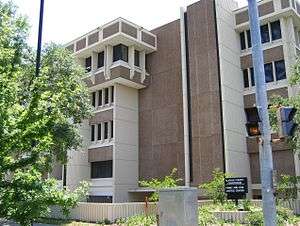

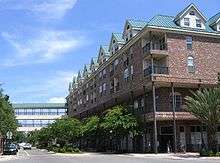
Since the 1990s, suburban sprawl has been a concern for a majority of the city commissioners. The "New Urbanization" plan to gentrify the area between historic Downtown and the University of Florida may slow the growth of suburban sectors and spark a migration toward upper-level apartments in the inner city. The area immediately north of the university is also seeing active redevelopment. Many gentrification plans rely on tax incentives that have sparked controversy[34] and are sometimes unsuccessful. University Corners, which would not have been proposed without a $98 million tax incentive program by the city,[35] was to be "a crowning jewel of the city's redevelopment efforts",[36] 450 condos and hotel units and 98,000 square feet (9,100 m2) of retail space in eight stories covering three city blocks,[37] on 3.4 acres (1.4 ha) purchased for $15.5 million.[38] 19 thriving businesses[34] were demolished in April 2007,[38] but in May 2008 deposit checks were refunded to about 105 people who reserved units,[39] and in July 2008 developers spent "$120,000 to beautify the site, so we won't have this ugly green fence."[38]
Gainesville's east side houses the majority of the city's African-American community, while the west side consists of the mainly student and white resident population. West of the city limits are large-scale planned communities, most notably Haile Plantation, which was built on the site of its eponymous former plantation.
The destruction of the city's landmark Victorian courthouse in the 1960s, which some considered unnecessary, brought the idea of historic preservation to the community's attention. The bland county building that replaced the grand courthouse became known to some locals as the "air conditioner". Additional destruction of other historic buildings in the downtown followed. Only a small handful of older buildings are left, like the Hippodrome State Theatre, at one time a federal building. Revitalization of the city's core has picked up, and many parking lots and underutilized buildings are being replaced with infill development and near-campus housing that blend in with existing historic structures. There is a proposal to rebuild a replica of the old courthouse on a parking lot one block from the original location.
Helping in this effort are the number of areas and buildings added to the National Register of Historic Places. Dozens of examples of restored Victorian and Queen Anne style residences constructed in the city's agricultural heyday of the 1880s and 1890s can be found in the following districts:
- Northeast Gainesville Residential District
- Southeast Gainesville Residential District
- Pleasant Street Historic District
Additionally, the University of Florida Campus Historic District, consisting of 11 buildings and 14 contributing properties, lies within the city's boundaries. Most of the buildings in the Campus Historic District are constructed in variations of Collegiate Gothic architecture, which returned to prominence in the late 19th and early 20th centuries.
Historic structures on the Register in and around downtown are:
- Bailey Plantation House (1854)
- Colson House (1905)
- Matheson House (1867)
- Thomas Hotel (1910)
- The Old Post Office (now the Hippodrome State Theatre) (1911)
- Masonic Temple (1908)
- Seagle Building (1926), downtown Gainesville's tallest building.
- Baird Hardware Company Warehouse (1890)
- Cox Furniture Store (1875)
- Cox Furniture Warehouse (c. 1890)
- Epworth Hall (1884)
- Old Gainesville Depot (1907)
- Mary Phifer McKenzie House (1895)
- Star Garage (1902)
- A. Quinn Jones House
Demographics
| Gainesville Demographics | |||
|---|---|---|---|
| 2018 Estimates | Gainesville | Alachua County | Florida |
| Total population | 133,857 | 269,956 | 21,299,325 |
| Population, percent change, 2000 to 2010 | +30.3% | +13.5% | +17.6% |
| Population density | 2,028.4/sq mi | 282.7/sq mi | 350.6/sq mi |
| White or Caucasian (including White Hispanic) | 66% | 70% | 77.4% |
| (Non-Hispanic White or Caucasian) | 57.3% | 61.4% | 54.1% |
| Hispanic or Latino (of any race) | 10.7% | 9.8% | 25.6% |
| Black or African-American | 22% | 20.6% | 16.9% |
| Asian | 6.9% | 6.1% | 2.9% |
| Native American or Native Alaskan | 0.3% | 0.3% | 0.5% |
| Pacific Islander or Native Hawaiian | 0.1% | 0.1% | 0.1% |
| Two or more races (Multiracial) | 3.8% | 2.8% | 2.1% |
| Historical population | |||
|---|---|---|---|
| Census | Pop. | %± | |
| 1890 | 2,790 | — | |
| 1900 | 3,633 | 30.2% | |
| 1910 | 6,183 | 70.2% | |
| 1920 | 6,860 | 10.9% | |
| 1930 | 10,465 | 52.6% | |
| 1940 | 13,757 | 31.5% | |
| 1950 | 26,861 | 95.3% | |
| 1960 | 29,701 | 10.6% | |
| 1970 | 64,510 | 117.2% | |
| 1980 | 81,371 | 26.1% | |
| 1990 | 84,770 | 4.2% | |
| 2000 | 95,447 | 12.6% | |
| 2010 | 124,354 | 30.3% | |
| Est. 2019 | 133,997 | [7] | 7.8% |
| U.S. Decennial Census[43] | |||
The US Census Bureau estimated Gainesville's population at 133,857 in 2018,[44] a 7.7% increase from 2010. At the 2010 census there were 51,029 households, with 2.2 persons per household. Children under the age of 5 were 4.4% of the population, under 18 13.4%, and people 65 years or over were 8.3% of the population. 64.9% of the population was white, 23.0% black, 6.9% Asian, 0.3% American Indians and Alaska Natives, 0.1% Native Hawaiians and Other Pacific Islanders, 1.9% some other race, and 2.9% reporting two or more races. 10.0% were Hispanic or Latino of any race, and 58.7% were non-Hispanic whites. 51.6% of the population were female. In 2007–11, the estimated median household income was $30,952 and the per capita income was $19,100.[45]
Economy
Numerous guides, such as the 2004 Cities Ranked and Rated: More than 400 Metropolitan Areas Evaluated in the U.S. and Canada, have mentioned Gainesville's low cost of living. The restaurants near the University of Florida also tend to be inexpensive. The property taxes are high to offset the cost of the university, as the university's land is tax-exempt, but the median home cost is slightly below the national average, and Gainesville residents, like all Floridians, do not pay state income taxes.
The city's job market scored only 6 out of a possible 100 points in the Cities Ranked and Rated guide, as the downside to the low cost of living is an extremely weak local job market that is oversupplied with college-educated residents. The median income in Gainesville is slightly below the U.S. average.
Gainesville heavily promoted solar power by creating the first feed-in tariff (FIT) in the United States. The FIT allowed small businesses and homeowners to supply electricity into the municipal power grid and paid a premium for the clean, on-site generated solar electricity. The FIT started with a rate of $0.32 per kilowatt-hour and allowed a person or business to enter into a 20-year contract where Gainesville Regional Utilities would purchase the power for 20 years.[47] The FIT ended in 2013,[48] when the rate was set at $0.18 per kWh, but the city is still seen as a leader in solar power. This increase in solar installations put Gainesville at number 5 in the world in solar installed per capita, beating Japan, France, China and all of the US.[49]
The sports drink Gatorade was invented in Gainesville in the 1960s as a means of refreshing the UF football team. UF still receives a share of the profits from the beverage, but Gatorade's headquarters are now in Chicago.
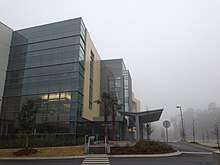
The Florida Department of Citrus's department of economic research is on the UF campus.[50]
Top employers
According to Gainesville's 2017 Comprehensive Annual Financial Report,[51] the top employers in the city are:
| No. | Employer | No. of Employees |
|---|---|---|
| 1 | University of Florida | 27,567 |
| 2 | UF Health | 12,705 |
| 3 | Gainesville Veterans Administration Medical Center | 6,127 |
| 4 | Alachua County School Board | 3,904 |
| 5 | City of Gainesville | 2,072 |
| 6 | North Florida Regional Medical Center | 2,000 |
| 7 | Gator Dining Services | 1,200 |
| 8 | Nationwide Insurance | 960 |
| 9 | Alachua County | 809 |
| 10 | Publix | 780 |
Startups
Greater Gainesville (Alachua County) is home to a thriving startup ecosystem with over 160 high growth enterprises.[52] Gainesville is also home to dozens of organizations that support startups along their entire continuum of growth.[53] To learn and participate in local startup events please visit UF Innovate's Community Calendar for Entrepreneurs: https://innovate.research.ufl.edu/event-calendar/.
Education
_(University_of_Florida).jpg)
The Gainesville urban area is served by Alachua County Public Schools, which has 75 different institutions in the county, most in the Gainesville area. Gainesville is also home to the University of Florida and Santa Fe College. The University of Florida is a major financial boost to the community, and UF athletic events, including SEC football games, create hundreds of thousands of dollars in additional revenue. According to a 2019 study by the university's Institute of Food and Agricultural Sciences, the university contributed $16.9 billion to Florida's economy and was responsible for over 130,000 jobs in the 2017–18 fiscal year.[54]
Desegregation
Gainesville began desegregating its schools in the 1960s. It integrated its high schools from 1968 to 1970. Its black schools were either closed or integrated.[55]
Elementary schools
- Boulware Springs Charter School
- Chiles Elementary School
- Duval Elementary School
- J. J. Finley Elementary School
- Foster Elementary School
- Glen Springs Elementary School
- Hidden Oak Elementary School
- Idylwilde Elementary School
- Lake Forest Elementary School
- Littlewood Elementary School
- Meadowbrook Elementary School
- WA Metcalfe Elementary School
- Norton Knights Elementary School
- Rawlings Elementary School
- Talbot Elementary School
- Terwilliger Elementary School
- Wiles Elementary School
- Williams Elementary School
Middle schools
Middle schools in the county run from 6th to 8th grades.
- Howard Bishop Middle School
- Fort Clarke Middle School
- Kanapaha Middle School
- Lincoln Middle School
- Westwood Middle School
High schools
High schools in Gainesville run from 9th to 12th grades.
Private schools
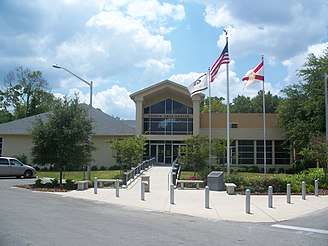
- Brentwood School
- Countryside Christian School
- Cornerstone Academy
- Gainesville Country Day School
- Millhopper Montessori School
- Oak Hall School
- Queen of Peace Academy
- St. Patrick Interparish School
- The Rock School
- Trilogy School of Learning Alternatives
- Westwood Hills Christian School
- St. Francis Academy
- Newberry Christian Community School
Colleges and universities
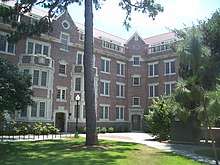
- University of Florida
- Santa Fe College
- Saint Leo University (Gainesville campus)
- City College (Gainesville campus)
Developmental research schools
City libraries
The Alachua County Library District provides public library service to a county-wide population (in 2013) of 253,451. The Library District has reciprocal borrowing agreements with the surrounding counties of Baker, Bradford, Clay, Columbia, Dixie, Gilchrist, Lafayette, Levy, Marion, Putnam, and Union. These agreements are designed to facilitate access to the most conveniently located library facility regardless of an individual's county of residence.
Government and infrastructure
City government
The council–manager government is the form of municipal government used in Gainesville. The day-to-day operations of the city are run by a professional city manager who is appointed by the elected city commission.[56]
Elected officials and elections
City commission
The legislative power of the city is vested in a city commission of seven members, one of whom is the mayor. The mayor and two other commissioners are elected at-large, while the other four are elected from single-member districts to represent a quarter of the city.[57]
The city commission is responsible for legislative functions such as establishing policy, passing local ordinances, voting appropriations, and developing an overall vision, like a corporate board of directors,[58] in addition to appointing several professional staff persons.
Mayor
The mayor is presiding officer of the city commission and has a voice and a vote in its proceedings but no veto power.[59]
- William Reuben Thomas, 1901-1907
- Horatio Davis, 1908-1909[60]
- ?
- Gordon Tison, circa 1918[61]
- ?
- Robert W. Davis, 1924-1925[60]
- ?
- J. Milton Brownlee, 1951[60]
- Fred M. Cone, 1952[60]
- Roy L. Purvis, 1953[60]
- C. B. Bohannon, Jr., 1954[60]
- Joseph C. Wise, 1955[60]
- Myrl J. Hanes, 1959[60]
- Perry McGriff, circa 1960s??
- ?
- Joseph W. Little, 1975-1976[62]
- ?
- Jean Chalmers, 1984-1985[62]
- Gary Gordon, 1985-1986
- N. David Flagg, 1987-1988[62]
- David Coffey, 1988-1989[62]
- Cynthia Moore Chestnut, 1989-1990[62]
- Rodney J. Long, 1991-1992[62]
- Paula M. DeLaney, 1994-1995, 1998-2001[62][63]
- Bruce L. Delaney, 1997-1998[62]
- Thomas D. Bussing, 2001-2004[62]
- Pegeen Hanrahan, 2004-2010
- Craig Lowe, 2010-2013
- Ed Braddy, 2013-2016[64]
- Lauren Poe since 2016
Elections and terms of office
Municipal elections are nonpartisan and use a two-round system, i.e., if no candidate receives a majority of the vote, a runoff election ensues between the two candidates who received the most votes.[65]
The mayor and other commissioners are elected to a term the length of which is in transition;[66] in any case, neither the mayor nor any other commissioner may serve more than two consecutive terms, excepting following a partial term created by a vacancy. Mayoral terms are reckoned separately from terms as another commissioner, allowing a commissioner to serve more consecutive terms by alternating between the positions.[67]
Administration
City manager
Departments
Law enforcement is provided by Gainesville Police Department, except on the University of Florida campus, which operates the University Police Department.
Fire protection within the city limits is provided by the Gainesville Fire Rescue, while the surrounding county is served by the Alachua County Fire Rescue. Alachua County Fire Rescue provides ambulance services for the whole county.
Municipal buildings
Gainesville's city hall is at 200 E University Avenue.
Transportation
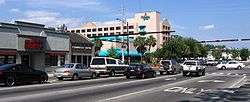
In 2009, the Gainesville metropolitan statistical area (MSA) ranked seventh highest in the United States in percentage of commuters who biked to work (3.3 percent).[68]
Major roads
Gainesville has an extensive road system, which is served by Interstate 75, and several Florida State Routes, including State routes 20, 24, and 26. Gainesville is also served by US 441 and nearby US 301, which give a direct route to Jacksonville, Ocala, and Orlando.









The city's streets lie on a grid system, with four quadrants (NW, NE, SW and SE). All streets are numbered, except for a few major thoroughfares, many of which are named for the towns they lead to (such as Waldo Road (SR 24), Hawthorne Road (SR 20), Williston Road (SR 121/SR 331), Archer Road (also SR 24) and Newberry Road (SR 26)). Streets called Avenues, Places, Roads or Lanes (often remembered by use of the acronym "APRiL") generally run east-west, while other streets (including Streets, Drives, Terraces, and Ways) generally run north-south.
Intercity rail
Amtrak Thruway Motorcoach buses connect with Jacksonville (Amtrak station) to the north and Lakeland (Amtrak station) to the south. Bus service connects with Amtrak's Silver Service. Amtrak service is available at Palatka, 32 miles (51 km) to the east.
At one time, Gainesville had railroad lines extending in six directions and was served by several depots. The earliest route reached the town in 1859. As traffic and business patterns changed, the less heavily used railroads were abandoned beginning in 1943, and some routes realigned, with the last trains running in the middle of Main Street in 1948.[69]
Passenger service included different Atlantic Coast Line Railroad (ACL) trains: the Havana Special, the West Coast Champion from New York City, and the Dixie Flyer from Chicago. Chicago service was furnished by a transfer at Jacksonville to the West Coast Champion. In 1967, the service continued on through Seaboard Coast Line Railroad which was created as a merger of ACL and Seaboard Air Line. However, by its final year of service, 1970, service was reduced to a Jacksonville-Gainesville-Trilby-St. Petersburg section.[70] Service into Gainesville had ended later in 1970, the year before Amtrak's creation.[71]
By the 1980s, the only freight operator into the city was the Seaboard System (formerly the Seaboard Coast Line Railroad, now merged into CSX).
Airport, bus, and others
In addition to its extensive road network, Gainesville is served by Gainesville Regional Transit System, or RTS, Florida's fourth-largest mass transit system. The area is also served by Gainesville Regional Airport ("GNV"[72]) in the northeast part of the city, with daily service to Atlanta, Dallas-Fort Worth,[73] Miami, and Charlotte, North Carolina.
According to the 2000 census, 5.25 percent of Gainesville residents commuted to work by bike, among the highest figures in the nation for a major population center.
Culture
Gainesville is known for its support of the visual arts. Each year, two large art festivals attract artists and visitors from all over the southeastern United States.[74]
Cultural facilities include the Florida Museum of Natural History, Harn Museum of Art, the Hippodrome State Theatre, and the Curtis M. Phillips Center for the Performing Arts. Smaller theaters include the Acrosstown Repertory Theatre (ART), Actors' Warehouse, and the Gainesville Community Playhouse (GCP). GCP is the oldest community theater group in Florida; in 2006, it christened a new theater building.[75]
The presence of a major university enhances the city's opportunities for cultural lifestyles. The University of Florida College of the Arts[76] is the umbrella college for the School of Music, School of Theatre and Dance, School of Art and Art History, and a number of other programs and centers including The University Galleries, the Center for World Art, and Digital Worlds. Collectively, the College offers many performance events and artist/lecture opportunities for students and the greater Gainesville community, the majority offered at little or no cost.
Since 1989, Gainesville has been home to Theatre Strike Force, the University of Florida's premier improv troupe. Gainesville also hosts several sketch comedy troupes and stand-up comedians.
In April 2003, Gainesville became known as the "Healthiest Community in America" when it won the only "Gold Well City" award given by the Wellness Councils of America (WELCOA).[77] Headed up by Gainesville Health & Fitness Centers, and with the support of Shands HealthCare and the Gainesville Area Chamber of Commerce, 21 businesses comprising 60 percent of the city's workforce became involved in the "Gold Well City" effort. As of July 2011, Gainesville remained the only city in the country to win the award.
The counties surrounding Alachua County vote strongly Republican, while Alachua County votes strongly Democratic.[78] In the 2008 election, there was a 22% gap in votes in Alachua County between Barack Obama and John McCain, while the other 11 candidates on the ballot and write-in votes received approximately 1.46% of the vote.[79]
Homelessness issues
The National Coalition for the Homeless cited Gainesville as the 5th meanest city in the United States for its criminalization of homelessness in the Coalition's two most recent reports (in 2004 and 2009),[80][81] the latter time for its meal limit ordinance.[82] Gainesville has a number of ordinances targeting the homeless, including an anti-panhandling measure and one prohibiting sleeping outdoors on public property. In 2005, the Alachua Board of County Commissioners and the Gainesville City Commission responded by issuing a written "Ten Year Plan to End Homelessness";[83][84] which was followed by the 2010 "A Needs Assessment of Unsheltered Homeless Individuals In Gainesville, Florida" presentation to a joint meeting of Gainesville and Alachua County Commissions.[85] An indoor homeless shelter was built on the site of the former Gainesville Correctional Institution grounds, with surrounding area designated for tents.[86]
Marijuana culture
Gainesville is renowned in recreational drug culture for "Gainesville Green", a particularly potent strain of marijuana. Orange and Blue magazine published a feature article in 2003 about the history of Gainesville Green and the local marijuana culture in general.[87] In the mid-1990s, several Gainesville Hemp Festivals took place outside the Alachua County courthouse.
Music scene
Gainesville is well known for its music scene and has spawned a number of bands and musicians, including Tom Petty and the Heartbreakers,[88] Stephen Stills, Don Felder and Bernie Leadon of The Eagles, The Motels, Against Me!, Charles Bradley, Less Than Jake, Hot Water Music, Loyal Revival, John Vanderslice, Sister Hazel, Hundred Waters, and For Squirrels. It is also the location of independent labels No Idea Records and Elestial Sound, and the former home of Plan-It-X Records, which moved to Bloomington, Indiana. For two years, the Gainesville nonprofit Harvest of Hope Foundation hosted the Harvest of Hope Fest in St. Augustine.[89] Gainesville is also the home of Florida Rocks, the founders of "Santa Jam", who hold concerts every December throughout North Florida as a toy fundraiser for sick, injured, and homeless children and a showcase for local musicians. Since 2011 they have distributed nearly 700 toys to hospitals, local churches, homeless charities, and needy families across the area.
No Idea Records puts on an annual three-day rock festival known as The Fest, typically during the last weekend in October, coinciding with the annual Florida-Georgia football game, played in Jacksonville to minimize tensions between the largely out of town music festival goers with the University of Florida students and alumni.[90]
Between 1987 and 1998, Gainesville had a very active rock music scene, with Hollywood star River Phoenix having the local club Hardback Cafe as his main base. Phoenix's band Aleka's Attic was a constant feature of the rock scene.[91] The Phoenix family is still a presence in Gainesville, with Rain Phoenix's band Papercranes and Liberty Phoenix's store, Indigo.[92]
Gainesville is still known for its strong music community and was named "Best Place to Start a Band in the United States" by Blender magazine in March 2008.[93] The article cited the large student population, cheap rent, and friendly venues.
Over the past decade, Gainesville has been home to a wide variety of bands, from the Latin/afrobeat sounds of Umoja Orchestra, to the rock of Morningbell, to ska staples The Know How.[94]
Gainesville's reputation as an independent music mecca can be traced back to 1984 when a local music video station was brought on the air. The station was called TV-69, broadcast on UHF 69 and was owned by Cozzin Communications.[95] The channel drew considerable media attention thanks to its promotion by Bill Cosby, who was part owner of the station when it started. TV-69 featured many videos by punk and indie-label bands and had several locally produced videos ("Clone Love" by a local parody band, and a Dinosaur Jr. song).
Sports
The Florida Gators is the varsity team of the University of Florida, competing in the Southeastern Conference of the National Collegiate Athletic Association since 1933. It has been ranked in the top 10 in the NACDA ranking since the 1983–84 season. It has won 40 national team championships, including two men's basketball titles, three football titles, four men's golf titles, and seven women's tennis titles.
Opened in 1969, the Gainesville Raceway is a dragstrip that hosts the Gatornationals, one of the four NHRA major races.
Startup culture
Roughly since the 2006 founding of Grooveshark, a Gainesville-based music streaming service, Gainesville has seen an increase in the number of technology-based startup companies founded and developed in the city, particularly the downtown area.[96][97][98] Among them are Digital Brands, SharpSpring, Fracture, Optym, and Feathr. The city celebrates Josh Greenberg Day annually in April, in honor of the late founder of Grooveshark and his contributions to the community's startup culture.[99]
Annual cultural events
- The Spring Arts Festival, hosted each year, usually in early April, by Santa Fe College (formerly Santa Fe Community College), is one of the three largest annual events in Gainesville and known for its high-quality, unique artwork.[100]
- The nationally recognized Downtown Festival and Art Show, hosted each fall by the City of Gainesville, attracts award-winning artists and a crowd of more than 100,000.[101]
- The Hoggetowne Medieval Faire has attracted thousands of fairgoers for over 20 years.[102]
- The Fest, a multi-day, multiple-venue underground music festival held annually in Gainesville since 2002.[103][104]
Media
Print
Gainesville is served by The Gainesville Sun and The Independent Florida Alligator, the student newspaper for the University of Florida and Santa Fe College.
The New York Times Editing Center also resides in Gainesville.[105]
Radio
Arbitron ranks the Gainesville-Ocala market as the nation's 83rd-largest.[106] Thirteen radio stations are licensed to operate in the city of Gainesville—five AM stations, six commercial FM stations, and two low-power non-commercial FM stations. Three of the stations (WRUF, WRUF-FM, and WUFT-FM) are operated by broadcasting students at the University of Florida. WUFT-FM is the city's NPR member station, while the WRUF stations are operated as commercial stations.
Television
Gainesville is the 162nd-largest television market in the nation, as measured by Nielsen Media Research.[107] Broadcast television stations in the Gainesville market include WCJB, an ABC/CW affiliate in Gainesville; WGFL, a CBS affiliate broadcasting from High Springs; WNBW, a NBC affiliate in Gainesville; WOGX, a Fox owned-and-operated station (O&O) from Ocala; WMYG-LP, an analog MyNetworkTV affiliate broadcasting from Lake City; and WUFT, the PBS station affiliated with the University of Florida in Gainesville.
WOGX bears the distinction of being the smallest network O&O in the United States, as a semi-satellite of another Fox O&O, WOFL in Orlando.
Points of interest
- 34th Street Wall
- Baughman Center
- Ben Hill Griffin Stadium at Florida Field
- Bivens Arm
- Civic Media Center
- Depot Park
- Devil's Millhopper Geological State Park
- Florida Museum of Natural History, including the Butterfly Rainforest exhibit
- Gainesville-Hawthorne Trail State Park
- Gainesville Raceway
- Haile Homestead
- Harn Museum of Art
- Helyx Bridge
- Hippodrome State Theatre
- Ichetucknee Springs State Park
- Kanapaha Botanical Gardens
- Lake Alice
- Marjorie Kinnan Rawlings Historic State Park
- Morningside Nature Center
- Newnan's Lake
- The Oaks Mall
- Paynes Prairie Preserve State Park
- San Felasco Hammock Preserve State Park
- Santa Fe College Teaching Zoo
- Stephen C. O'Connell Center
- William Reuben Thomas Center
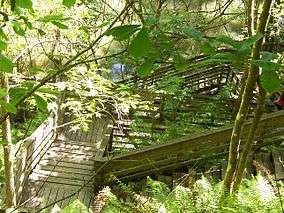 Boardwalk at Devil's Millhopper
Boardwalk at Devil's Millhopper Newnans Lake
Newnans Lake Sweetwater Wetlands Park at Payne's Prairie
Sweetwater Wetlands Park at Payne's Prairie- The Oaks Mall
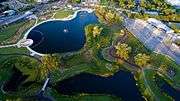 Gainesville's Depot Park
Gainesville's Depot Park
Sister cities
Gainesville maintains sister city relationships with eight cities:[108]


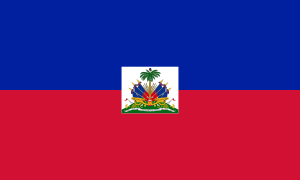

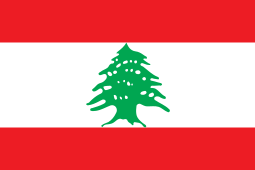
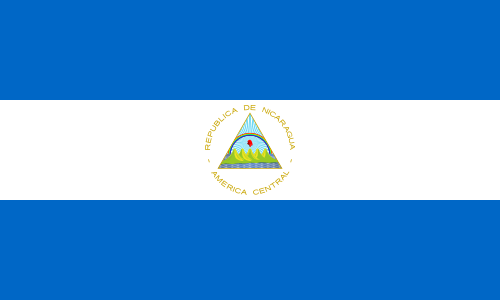


References
- "Hogtown historical marker".
- "City Of Gainesville > City Commission". Cityofgainesville.org. Retrieved August 1, 2020.
- Gainesville, Florida's City Commission (November 12, 2019). "About the City Manager". City Manager. City of Gainesville, Florida. Retrieved January 13, 2020.
- "2019 U.S. Gazetteer Files". United States Census Bureau. Retrieved July 2, 2020.
- "Gainesville, Florida". Weather Underground. Retrieved July 22, 2007.
- "Annual Estimates of the Resident Population for Incorporated Places: April 1, 2010 to July 1, 2012". U.S. Census Bureau. Archived from the original on October 19, 2013. Retrieved June 1, 2015.
- "Population and Housing Unit Estimates". Retrieved May 21, 2020.
- "US Board on Geographic Names". United States Geological Survey. October 25, 2007. Retrieved January 31, 2008.
- Bureau, U. S. Census. "U.S. Census website". United States Census Bureau. Retrieved May 25, 2019.
- "Paleo-Indians in Florida". www.treasurenet.com. Retrieved June 10, 2019.
- "Florida Historical Markers Programs - Marker Detail - Preservation - Florida Division of Historical Resources". apps.flheritage.com. Retrieved June 10, 2019.
- Milanich, Jerald T. (1998). Florida's Indians from ancient times to the present. Gainesville: University Press of Florida. ISBN 0813022002. OCLC 48138342.
- Andersen, Lars. (2014). Paynes Prairie. Pineapple Press, Inc. ISBN 978-1561646654. OCLC 915153938.
- Tebeau, Charlton W.; Marina, William (1999). A history of Florida (3rd ed.). Coral Gables, Fla.: University of Miami Press. ISBN 0870243381. OCLC 43972863.
- Florida; a Guide to the Southern-Most State. 1939. p. 380.
- Gannett, Henry (1905). The Origin of Certain Place Names in the United States. US Government Printing Office. p. 133.
- Florida Legislative Committee on Intergovernmental Relations (2001), Overview of Municipal Incorporations in Florida (PDF), LCIR Report, Tallahassee, archived from the original (PDF) on April 28, 2017
- Chrisholm, Hugh, ed. (1911). The Encyclopaedia Britannica: A Dictionary of Arts, Sciences, Literature and General Information, Volumes 11-12. University Press.
- "University of Florida History". December 27, 2008. Archived from the original on December 27, 2008. Retrieved June 10, 2019.
- "US Gazetteer files: 2010, 2000, and 1990". United States Census Bureau. February 12, 2011. Retrieved April 23, 2011.
- "Geographic Identifiers: 2010 Demographic Profile Data (G001): Gainesville city, Florida". U.S. Census Bureau, American Factfinder. Archived from the original on February 12, 2020. Retrieved May 6, 2013.
- Andreu, Michael G.; Fox, David A.; Landry, Shawn M.; Northrop, Robert J.; Hament, Caroline A. (March 1, 2017). City of Gainesville Urban Forest Ecological Analysis 2016 (PDF) (Report). p. 16. Retrieved June 22, 2019.
Based on Eco sample plot data collected, the estimated average tree canopy cover of Gainesville is 47%
- "University of Florida Facts". University of Florida. Archived from the original on May 20, 2011. Retrieved May 18, 2011.
- "Ohio State named nation's largest college – again". Dayton Business Journal. October 20, 2008. Retrieved June 30, 2011.
- "USDA Plant Hardiness Zone Map". United States Department of Agriculture. Archived from the original on February 27, 2014. Retrieved March 22, 2018.
- "Monthly Averages for Gainesville, Florida". The Weather Channel. Archived from the original on October 23, 2007. Retrieved July 22, 2007.
- "NowData - NOAA Online Weather Data". National Oceanic and Atmospheric Administration. Retrieved May 29, 2019.
- "Gainesville Records for February". National Weather Service. Retrieved July 21, 2007.
- Kneale, Dennis (January 19, 1977). "Snow in Gainesville? Here's what it looked like in 1977". The Independent Florida Alligator. Retrieved December 9, 2018.
- Alexander, Jackie (December 26, 2010). "NWS confirms Sunday morning snow flurries for Gainesville". The Gainesville Sun. Retrieved September 30, 2018.
- Callahan, Joe (January 3, 2018). "Snow in Gainesville? Could happen Wednesday". Gainesville Sun. Retrieved December 9, 2018.
- Mean monthly maxima and minima (i.e. the highest and lowest temperature readings during an entire month or year) calculated based on data at said location from 1981 to 2010.
- "Station Name: FL GAINESVILLE RGNL AP". National Oceanic and Atmospheric Administration. Retrieved March 22, 2018.
- Randy Jewett. "City shouldn't pay for University Corners". Alligator.org. Retrieved October 17, 2017.
- KATIE GALLAGHER. "Court case makes future uncertain for University Corners". Alligator.org. Retrieved October 17, 2017.
- JEFF ADELSON. "Will University Corners see daylight?". Gainesville.com. Retrieved October 17, 2017.
- Anthony Clark. "Work on Stadium Club to resume; University Corners still on hold". Gainesville.com. Retrieved October 17, 2017.
- Megan Rolland. "University Corners cleans up for church". Gainesville.com. Retrieved October 17, 2017.
- APRIL DUDASH. "Developers of stalled University Corners complex return checks". Alligator.org. Retrieved October 17, 2017.
- "Innovation Square » Innovation Square. Innovation and Community Redefined". Innovationsquare.ufl.edu. Retrieved October 5, 2016.
- Curry, Christopher (December 3, 2012). "University Corners project back before the city". Gainesville.com. Retrieved June 7, 2015.
- "The Continuum Apartments". Thecontinuumforufgrads.com. Retrieved October 5, 2016.
- "U.S. Decennial Census". Census.gov. Retrieved June 1, 2013.
- "Population and Housing Unit Estimates". Retrieved May 25, 2019.
- "State and County QuickFacts Gainesville (city), Florida". U.S. Census Bureau. Archived from the original on July 9, 2012. Retrieved June 20, 2012.
- "Data Center Results". Mla.org. Retrieved June 20, 2016.
- "Gainesville, Florida Solar Power Feed-In Tariff Program Maxed Out Before It Begins". Treehugger.com. Retrieved June 20, 2016.
- Curry, Christopher (December 19, 2013). "City Commission will not add to feed-in tariff in 2014". Gainesville.com. Retrieved June 7, 2015.
- Farrell, John (January 6, 2012). "Gainesville, Florida, Becomes a World Leader in Solar". CleanTechnica. Retrieved June 7, 2015.
- "Contact" (Archive). Florida Department of Citrus. Retrieved on September 13, 2015. "Florida Department of Citrus Economic Research 2125 McCarty Hall – University of Florida Gainesville, Florida 32611-0249 USA"
- "City of Gainesville CAFR" (PDF). Cityofgainesville.org. Archived from the original (PDF) on August 2, 2018. Retrieved August 2, 2018.
- https://docs.google.com/spreadsheets/d/1fVxPFPRMQSzoEwjTlAesFSbhyYqlEriJfTfg8Un9XGA/edit?usp=sharing
- https://www.google.com/maps/d/u/1/edit?hl=en&mid=1nrxakgZnTohIb2BE4bLD7n8aNbUphWli&ll=29.618570368518334%2C-82.67273771147164&z=9
- "Economic Contributions of the University of Florida and Related Entities in 2017-1" (PDF). Ifas.ufl.edu. Archived (PDF) from the original on November 4, 2019. Retrieved February 17, 2020.
- Michael Gengler, 'Alternet,' August 27, 2018 "Teachers Were the Real Heroes of School Desegregation: Often overlooked in histories of school desegregation are the teachers" https://www.alternet.org/news-amp-politics/teachers-were-real-heroes-school-desegregation
- Gainesville, Florida's City Commission (November 12, 2019). "About the City Manager". City Manager. City of Gainesville, Florida. Retrieved January 11, 2020.
- Gainesville, Florida's City Commission (November 12, 2019). "City Commission". Gainesville, Florida - Code of Ordinances. Municode. Retrieved January 19, 2020.
- "ICMA information brochure". Archived from the original on September 4, 2006. Retrieved January 16, 2020.
- Gainesville, Florida's City Commission (November 12, 2019). "2.08. - Mayor". Gainesville, Florida - Code of Ordinances. Municode. Retrieved January 13, 2020.
- Lawrence Kestenbaum (ed.). "Mayors of Gainesville, Florida". Political Graveyard. Retrieved April 20, 2017.
- History of Florida, Past and Present: Historical and Biographical. Chicago: Lewis Publishing Company. 1923.
- "Gainesville mayors, past and present, oppose the road tax", Gainesville Sun, October 25, 2012
- "City Commission". Gainesville, Florida Official Homepage. Archived from the original on December 5, 2000 – via Internet Archive, Wayback Machine.
- "Poe Defeats Braddy In Gainesville Mayoral Race", WUFT.org, University of Florida, March 15, 2016
- "Municode Library". library.municode.com. Retrieved January 19, 2020.
- Kim A. Barton. "Kim A. Barton: Expanded early voting part of city election changes". The Gainesville Sun. Archived from the original on January 11, 2020. Retrieved January 19, 2020.
- Gainesville, Florida's City Commission (November 12, 2019). "Eligibility". Gainesville, Florida - Code of Ordinances. Municode. Retrieved February 7, 2020.
- "Commuting in the United States: 2009" (PDF). American Community Survey Reports. September 2011. Archived from the original (PDF) on July 26, 2017. Retrieved December 26, 2017.
- Florida Railroad from Fernandina to Cedar Key history florida
- Seaboard Coast Line timetable, April 26, 1970, Tables 9, 10, 11
- Seaboard Coast Line timetable, December 11, 1970, Table 12
- "Airport Codes". Retrieved January 19, 2018.
- Caplan, Andrew (March 3, 2019). "Nonstop service between Dallas-Fort Worth and Gainesville available". The Gainesville Sun. Retrieved June 15, 2019.
- Mallard, Aida (November 13, 2019). "Downtown Festival will draw thousands of art, culture fans". The Gainesville Sun. Retrieved December 6, 2019.
- DAVE SCHLENKER. "Time to raise the curtains". Gainesville.com. Retrieved October 17, 2017.
- "College of the Arts - University of Florida". Arts.ufl.edu. Retrieved June 20, 2016.
- "Gainesville Goes Gold!". The Wellness Councils of America. May 2003. Archived from the original on May 14, 2008. Retrieved April 21, 2008.
- "County Results–Election 2008". CNN. November 7, 2008. Retrieved March 13, 2009.
- "Official Results — General Election — November 4, 2008 — Summary For Jurisdiction Wide, All Counters, All Races" (PDF). Alachua County Supervisor of Elections. Archived from the original (PDF) on September 27, 2011. Retrieved July 24, 2011.
- "Illegal to be Homeless". National Coalition for the Homeless. November 2004. Retrieved July 22, 2007.
- ROBERTA O. ROBERTS. "City named fifth meanest to homeless". Alligator.org. Retrieved October 17, 2017.
- "Parks as soup kitchens – Under The Sun - Gainesville Sun". October 30, 2011. Archived from the original on October 30, 2011. Retrieved October 17, 2017.
- "Archived copy" (PDF). Archived from the original (PDF) on July 7, 2011. Retrieved July 8, 2011.CS1 maint: archived copy as title (link) "The City of Gainesville/Alachua County Ten Year Plan to End Homelessness", Retrieved 2011-07-07
- "Ten Year Plan to End Homelessness" (PDF). Alachua County Commission. Archived from the original (PDF) on July 11, 2007. Retrieved July 22, 2007.
- "Alachua County/City of Gainesville Quarterly Special Meeting — Meeting Agenda August 30, 2010" (PDF). Meetingdocs.alachuacounty.us. Retrieved July 7, 2011.
- "Indoor homeless shelter opens Wednesday". Gainesville.com. Retrieved October 8, 2015.
- Battey, Brandon (Fall 2003). "Gainesville Green isn't just a color". Orange and Blue. Archived from the original on July 4, 2007. Retrieved July 22, 2007.
- Turner, Jim (August 4, 2019). "Tom Petty historical marker to be placed in Gainesville where he grew up". Sun-Sentinel. Retrieved February 19, 2020.
- "Harvest of Hope Festival". No Idea Records. March 2009. Archived from the original on February 28, 2009. Retrieved March 3, 2009.
- "Four arrested for punching and kicking GPD officer". The Independent Florida Alligator. November 2009.
- "Hardback Cafe Archive". Alan Bushnell. May 2007. Archived from the original on December 31, 2008. Retrieved July 19, 2008.
- "Liberty Phoenix's Indigo". The Gainesville Sun. May 2007. Retrieved July 19, 2008.
- "Gainesville named best place to start a band in America". Blender Magazine. March 2008. Archived from the original on June 5, 2009. Retrieved July 19, 2008.
- "Current Gainesville Bands". www.gainesvillebands.com. July 2008. Retrieved July 19, 2008.
- Gainesille's Only Music Video Station, 1996, archived from the original on June 15, 2011, retrieved July 19, 2008
- Frankel, Ryan (October 30, 2014). "An Insider's Perspective: The Good, The Bad and The Ugly of Gainesville Startups". Business in Greater Gainesville. Retrieved November 20, 2017.
- Schweers, Jeff (April 28, 2013). "Gainesville's Startup Alley covets UF computer grads". The Gainesville Sun. Retrieved November 20, 2017.
- Stein, Ron. "Gainesville has become a tech hub for engineering entrepreneurs". Florida Trend. Retrieved November 20, 2017.
- Whitely, Richard (April 20, 2016). "Gainesville Remembers Grooveshark Co-Founder With 'Josh Greenberg Day'". WUFT. Retrieved November 20, 2017.
- "Spring Arts Festival - My WordPress Blog". Spring Arts Festival. Archived from the original on December 11, 2015. Retrieved October 17, 2017.
- "Archived copy". Archived from the original on July 14, 2011. Retrieved July 7, 2011.CS1 maint: archived copy as title (link) "Downtown Festival & Art Show", Retrieved 2011-07-07
- "Archived copy". Archived from the original on July 14, 2011. Retrieved July 7, 2011.CS1 maint: archived copy as title (link) "Hoggetowne Medieval Faire", Retrieved 2011-07-07
- @thefestfl. "The Fest 16 » History". The Fest 16. Retrieved October 17, 2017.
- Levi Bradford (October 26, 2016). "Fifteen years of Fest". The Gainesville Sun. Retrieved May 4, 2017.
- "The New York Times is relocating some wire service positions to Gainesville, creating about 25 jobs". Ocala.com. Retrieved June 20, 2016.
- "Market Ranks and Schedule". Arbitron, Inc. Retrieved September 6, 2007.
- "Local Television Market Universe Estimates". The Nielsen Company. Retrieved September 6, 2007.
- "Sister City Program of Gainesville". Sister City Program of Gainesville, Inc. Archived from the original on January 5, 2010. Retrieved December 14, 2018.
Further reading
- Andersen, Lars (2004). Paynes Prairie: The Great Savanna: A History and Guide. Sarasota, Florida, USA: Pineapple Press. ISBN 1-56164-296-7. Retrieved May 18, 2011.
- Braley, R. Olin (2004). The Killing of Harmon Murray: Being a True Account of the Life and Times of Florida's Premier Black Outlaw. Gainesville, Florida: The Alachua Press.
- Fox, Kathleen A.; Lane, Jodi (2010). "Perceptions of gangs among prosecutors in an emerging gang city". Journal of Criminal Justice. 38 (4): 595–603. doi:10.1016/j.jcrimjus.2010.04.031.
- Hicks, Rob (2008). Images of America: Gainesville. Arcadia Publishing. ISBN 978-0-7385-5402-0.
- Hildreth, Charles H.; Merlin G. Cox (1981). History of Gainesville, Florida 1854-1979. Gainesville, Florida: Alachua County Historical Society.
- McCarthy, Kevin M.; Murray D. Laurie (1997). Guide to the University of Florida and Gainesville. Sarasota, florida: Pineapple Press. ISBN 1-56164-134-0.
- Milanich, Jerald T. (1995). Florida Indians and the Invasion from Europe. Gainesville, Florida, USA: University Press of Florida. ISBN 0-8130-1636-3.
- Milanich, Jerald T. (1998). Florida's Indians from Ancient Times to the Present. Gainesville, Florida, USA: University Press of Florida. ISBN 0-8130-1598-7.
- Milanich, Jerald T. (1999). The Timucua. Oxford, UK: Blackwell Publishers. ISBN 0-631-21864-5.
- Milanich, Jerald T. (2006). Laboring in the Fields of the Lord: Spanish Missions and Southeastern Indians. Gainesville, Florida, USA: University Press of Florida. ISBN 0-8130-2966-X.
- Newton, Michael (2001). The Invisible Empire: The Ku Klux Klan in Florida. Gainesville, Florida: The University Press of Florida. ISBN 0-8130-2120-0.
- Pickard, Ben (1991). Historic Gainesville: a tour Guide to the Past. Gainesville, Florida: Historic Gainesville, Inc.
- Rajtar, Steve (2007). A Guide to Historic Gainesville. Charleston, South Carolina; London: History Press. ISBN 978-1-59629-217-8.
- Taulbee, Lindsay. "Gainesville in the '70s: Changes roiling beneath a polite Southern surface". Gainesville Magazine. Gainesville Sun. Retrieved May 13, 2011.
- Washington, Ray. "University of Florida: Unrest amid the boom times 1960-1980". Gainesville Sun. Gainesville Sun. Retrieved May 13, 2011.
External links
| Wikimedia Commons has media related to Gainesville, Florida. |
- Official website
- Gainesville Florida Visitors & Convention Bureau
- Gainesville Area Chamber of Commerce

